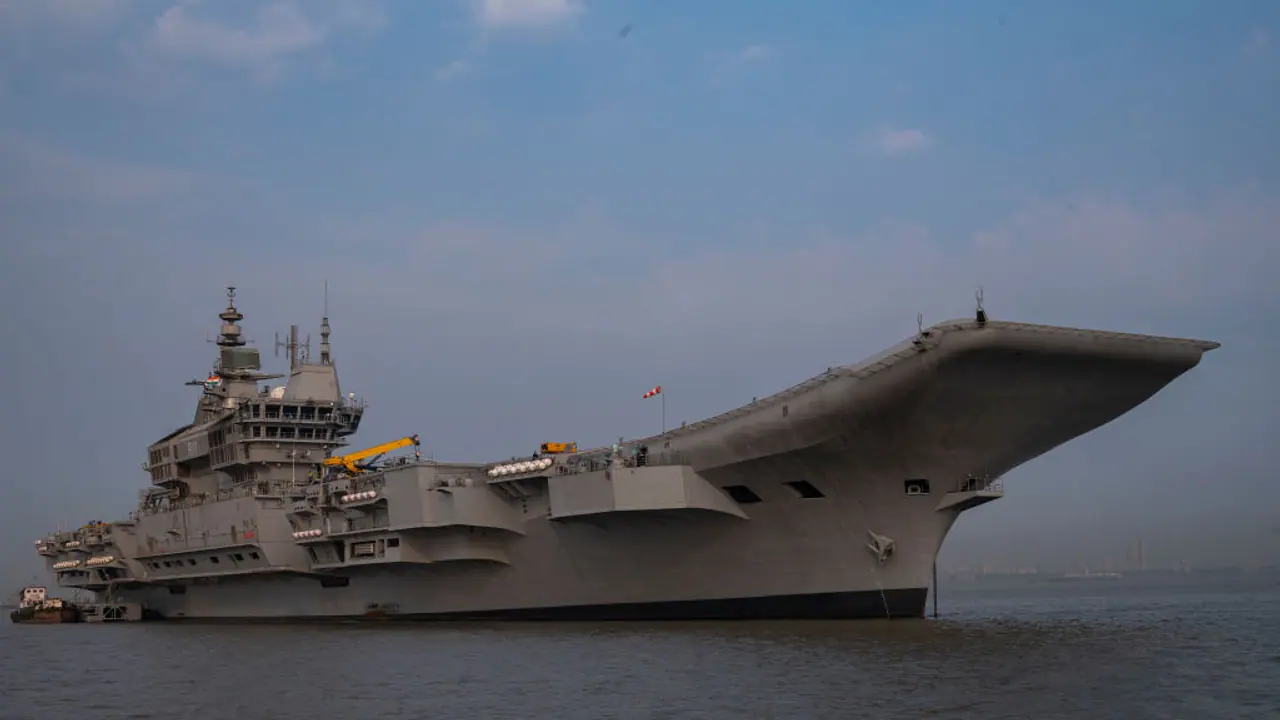India's pursuit of a third aircraft carrier, the Indigenous Aircraft Carrier-2 (IAC-2), is vital for securing maritime dominance, countering China, boosting economic and industrial growth, and reinforcing its position as a leading Indo-Pacific power.
New Delhi: Amid the evolving dynamics of the Indian Ocean Region (IOR)—a hub of global trade, strategic chokepoints, and intensifying geopolitical tensions—India faces critical decisions to secure its maritime dominance and economic resilience.

As China’s naval expansion accelerates and the Indo-Pacific emerges as a focal point of global power shifts, the case for India’s third aircraft carrier grows increasingly compelling. The proposed Indigenous Aircraft Carrier-2 (IAC-2) is not merely an addition to the fleet; it is a strategic imperative, an economic catalyst, and a testament to India’s maritime ambitions.
Also read: INS Nirdeshak: What It symbolises and why that’s important
IOR: The Epicenter of Global Trade and Security
The IOR is home to some of the world’s most vital sea lines of communication (SLOCs), connecting Europe, the Middle East, and Asia. It accounts for nearly 95% of India’s trade by volume and 70% by value, making maritime security indispensable for India’s economic stability.
China’s growing footprint in the region—marked by dual-use port facilities in Sri Lanka, Pakistan, and Djibouti, and the commissioning of its third aircraft carrier, Fujian—accentuates the strategic competition unfolding in these waters.
Equipped with advanced Electromagnetic Aircraft Launch Systems (EMALS) and a displacement of 80,000 tonnes, the Fujian signals Beijing’s ambition to dominate the Indo-Pacific maritime domain. For India, maintaining maritime superiority in the IOR is critical to counterbalance China’s growing influence and ensure freedom of navigation.
Why a Third Aircraft Carrier Matters
India’s Navy operates two carriers — the Russian-built INS Vikramaditya and the indigenously constructed INS Vikrant, commissioned in 2022. While these assets are significant, operational constraints mean only one carrier is typically available at a time due to maintenance cycles. A third carrier would address this limitation, allowing India to maintain a continuous presence on its eastern and western seaboard.
It would also enable India to respond swiftly to humanitarian and disaster relief (HADR) missions, a role carriers have historically excelled in. The IAC-2 is envisioned as an upgraded version of INS Vikrant, incorporating lessons learned from its construction. With greater indigenous content, improved design features, and advanced systems, the IAC-2 will be critical to ensure India’s maritime readiness in the 21st century.
The Strategic Debate: Sea Control versus Sea Denial
Within the Indian defence establishment, opinions remain divided over the role of aircraft carriers. Proponents of a sea control strategy argue that carriers are indispensable for projecting power and securing SLOCs. Critics advocate for a sea denial approach, emphasising submarines as cost-effective and stealthy tools to counter adversaries like China and Pakistan.
Both strategies have merit. Submarines excel in anti-access/area denial (A2/AD) operations, while carriers offer unmatched operational flexibility. Rather than choosing between the two, India must adopt a balanced approach where carriers and submarines complement each other.
Retaining Shipbuilding Expertise
The construction of INS Vikrant marked a watershed moment for India’s shipbuilding industry. Building the IAC-2 ensures that the skills and industrial ecosystem developed during Vikrant’s construction are not lost. Cochin Shipyard Limited (CSL), which built Vikrant, can further refine its capabilities, contributing to India’s long-term naval self-reliance.
Economic and Technological Benefits
The IAC-2 project is not just a strategic investment—it is an economic one. The construction of Vikrant created over 14,000 direct and indirect jobs, engaging 500 micro, small, and medium enterprises (MSMEs). A new carrier project would replicate this success, providing a much-needed economic boost, particularly in coastal regions. Additionally, carrier construction stimulates innovation in high-tech sectors such as steel, electronics, and advanced manufacturing. Approximately 65% of the value addition in shipbuilding comes from ancillary industries, fostering a collaborative ecosystem that drives technological progress.
Overcoming Challenges
Critics of aircraft carriers often highlight their vulnerabilities to modern threats like anti-ship missiles and cyberattacks. Advances in Chinese A2/AD capabilities have made carriers more susceptible, leading even the United States Navy to reassess its carrier strategies. While these concerns are valid, carriers remain indispensable when integrated into balanced fleets with submarines, destroyers, and surveillance assets.
Emerging technologies like unmanned aerial vehicles (UAVs) and improved missile defence systems can further enhance their survivability. The financial cost of building the IAC-2—estimated at $5-6 billion—also raises concerns, especially concerning competing demands for defence resources. However, strategic public-private partnerships and prioritising indigenisation can help offset these expenses.
The Vision for 2030 and Beyond
The IAC-2 is not the end of India’s carrier ambitions but a stepping stone. In the long term, India must aspire to build larger, nuclear-powered carriers equipped with cutting-edge technologies like EMALS and advanced radar systems.
Such carriers would solidify India’s position as a leading maritime power in the Indo-Pacific and beyond. Moreover, as India develops its carrier-building capabilities, it can position itself as a regional hub for maintenance and refitting services, enhancing its defence export potential.
Also read: Opinion | INS Tushil: A Fusion of Russian and Ukrainian Technology in India's New Frigate
A Strategic and Economic Necessity
In a rapidly evolving maritime environment, the IAC-2 is not just an option but a necessity. It secures India’s maritime interests, reinforces its position as a net security provider, and strengthens its industrial and technological base. For India to emerge as a global maritime power, it must think beyond immediate challenges and invest in capabilities that ensure long-term security and economic resilience.
A third aircraft carrier is not just a platform but a strategic enabler that will define India’s role in the Indo-Pacific for decades. By committing to this vision, India can shape a future that safeguards its waters and builds a secure, prosperous, and stable maritime order.
